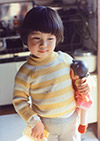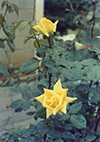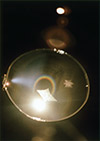past exhibition
父のアルバム/不思議な力 - 野口里佳
Weekdays 11:00 - 20:00
Weekends and Holidays 11:00 - 18:30
Mondays and Tuesdays Closed(Except for Holidays)
Entrance Fee 800 yen for over 18

commentary
見えないものの深さに向かって――野口里佳の写真の力
日高 優(写真批評家)
車中に座る女性と男性、そのふたつの面差しが響きあう優しいニュアンス。 シャーレの中で氷が溶けてゆく過程で起こる、雪の結晶に似た生成変化。
進みゆく時間のなかで押し流されて見えなかったり、見るには大きすぎたり小さすぎたり、この私たちの目には普段は見えない、だけど潜在するもの。そんなものがこの宇宙には確かに存在している。野口里佳は写真に撮ったりそれを並べたりすることではじめて見えてくる、そんなものにいつだってまっすぐまなざしを注いできた。潜在するものを見えるようにすること、それを感じさせること。そうした写真の本質的な力に、野口は一直線に向かっていく。
人が見ないもの、人には見えにくいものを見ようとして野口はこれまで作品をつくってきた。記号化されて消費される富士山や砂漠のイメージに実は隠されている、様々な陰影やその豊かさを探しに行く。強烈な光で見えにくい太陽に直接カメラを向けてまで見ようとする。人間の側から世界を見るのではなく、世界の側から人間が点景となるように世界を見る。何事かを見るためには、みずから海の中に潜ったり、自作の紙ロケットを飛ばしたり、シルクスクリーンも手がけたりする。見るために日常や惰性を解除して、ちょっとくらい無茶だってする。そうして出会ってしまったことに目を開きどこまでも従っていく、真っ正直な写真家だ。
そんな野口が新しい二つのシリーズで構成したのが本展だ。ひとつは、昨年亡くなった父が遺したネガを写真家自身がプリントしたシリーズ。もうひとつは、プリズムに分解される光の色やコップの水の表面張力など、見えないものを見えるようにする、自由研究のような小さな実験のシリーズ。 前者は要するに人間的で、後者は無機的な物質を巡る潜在性のシリーズだ。この二つのシリーズが今回ギャラリー916に提示された。これは一見大きく隔たって見えるシリーズが二つ投げ出されただけだろうか?無謀な試みなのだろうか?
野口が今回の展示の一貫性を内側からどのように感じているのか、私には分からない。けれどオリンパスペンというハーフサイズのカメラで父が撮りためた写真からひとつのシリーズが生み落され、その遺されたカメラを手にした彼女が、もうひとつの小さな実験のシリーズを生み落している。この微かな、しかし明確な繋がりは、見落とされるべきではないと思う。この写真家の、自身の鋭敏な感覚の導きに身をゆだねることのできる強靭な柔らかさ、それに導かれていく勇気を私たちも持とう。
父の撮った写真のシリーズが野口の作品と呼べるのか、という疑問はもちろん起こるだろう。撮影者は父で、内容も極めて個人的には違いない。だが野口が父のネガをプリントしながら父のまなざしを辿りなおすとき、父のまなざしに野口自身のそれが浸透していく深く親密で個人的なモメントがあったはずだ。その幸福な感じ、感覚は直接には当人だけのものだけれど、それは野口のプリントと編集の後では、第三者にも共有されうるものになるだろう。そしてこのシリーズは、実験シリーズと対にされると「見えないものを見る」というテーマのもと、シリーズとして、作品として、一挙に自らを開く。私は、家族アルバムをも「見えないものを見る」というテーマのもとにおく、野口の知覚の努力をもって、このシリーズを彼女の作品と認めるのだ。他方の実験の写真は今作がはじめてではないけれど、父のシリーズと出会いその無機的なイメージが厚みを孕み、そこに記憶という時間の軸が立ち上がってくる。そうして彼女の作品が一層の深さをもつ。
愛、なんてものは目に見えないが、例えば、飽くことなく何枚も撮られた写真の中のバラたちの姿が、一人の男性のバラへの愛を見えるものにする。雨の滴に濡れるバラの黄色い花弁や葉、その向こうの窓ガラス。さまざまなディテールやニュアンスが、それに触れるように見る私たちのまなざしのもとで出会い、すれ違い、反響しあい、それぞれのバラのイメージを一層深いものとする。撮影者の妻だって子供たちだって、同様に深くなる。台所の母、食卓に座る私。強くまっすぐに向けられる少女のまなざしと、受け止める父の呼応しあう信頼。弟と妹。深くなりながら、一個一個の身体、一筋ずつの命の〈わだち〉を浮かび上がらせている。存在の深さもわだちも、肉眼には見えない。だからこそ写真は、写真によって見ることが可能になるその豊かなバラのディテールや差異を味わう喜びへと、生の深さの経験へと、私たちをいざなう。バラの記憶はバラの写真を見るたびに深くなり、おまけにバラを巡るその他の記憶や知覚とより合され、新たなものとして絶えず生成してくる。写真にいざなわれて見るとき、私たちはバラを愛しシャッターを切ったというこの見知らぬ〈父〉とともに、そして父のまなざしを追走/追想する写真家とともに、まなざしの幸福を知るだろう。この喜びは、幻でもなければ、偽物でもない。目には見えないから、感じにくいだけだ。
だから小さな実験のシリーズも、いくらだって深くなる。一匙の蜂蜜の写真は柔らかな光を帯びた滴と指先のニュアンスや、バラの滴とさざめきあって、深く眠っていた子供時代の記憶を呼び覚ましていく。陽に翳されたプリズムの写真は、光の色彩分割の記録であるとともに、光に魅了された太古からの人類の記憶を呼び集める魔法のかけらともなる。
見えないものは、至る所に潜在している。至る所で探索できる。家族アルバムのなかでさえも。今回、写真家は、写真の原点に出会い直したに違いない。
Towards the profundity of the invisible:
The power of Rika Noguchi’s photographs
Yu Hidaka (photography critic)
A man and woman sitting in a car; the gentle nuances of their resonating features. A generative change similar to the crytallization of snow, that occurs in the process of ice melting in a petri dish.
That which is pushed along hidden from view as time progresses, is too big or too small to see; that which our eyes cannot normally see, but which lies concealed. There can be no doubt that in this universe, such things exist. Rika Noguchi has consistently channeled her gaze directly at that which only becomes visible when captured in photographs, and arranged for us to see. Taking the hidden and making it visible, helping us sense it: Noguchi heads straight to the heart of this essential power of photography.
Noguchi has consistently produced works that attempt to see what people do not look at, what people cannot see; heading off in a search for the myriad shadows, and the richness of those shadows, that in fact lie buried in images rendered symbolic, and consumed, such as images of Mt. Fuji, or the desert, even if it means pointing her camera directly at the sun, made difficult to discern by its fierce light. Rather than viewing the world from the human side, Noguchi views the world from the world’s side, in such a way that human beings become incidental details. In order to see something, she dives under the sea, makes her own homemade paper rocket fly, tries her hand at silk screening. In order to see she rescinds the routine and habitual, even adding a little absurdity to the mix. Noguchi is the most honest of photographers, opening her eyes to what she happens to encounter along the way, and following it as far as it will take her.
This then is Noguchi the photographer, and this exhibition composed by her consists of two new series. The first is a series of photos she personally printed from negatives left by her father, who passed away last year. The other is a series of small experiments, independent studies of a sort, in which she makes the invisible visible, e.g. the colors of light split through a prism, the surface tension on a glass of water. The former is in short, human; the latter showcasing the latent qualities of inorganic substances. These two series were on this occasion presented at Gallery 916. Was it simply a case of two at first glance disparate series being thrown together? An unthinking experiment?
I have no idea how Noguchi feels from the inside about the coherence of these exhibits. But one series was born out of photographs accumulated by her father on a half-size camera called an Olympus Pen, and she, taking the camera left to her, then proceeded to give birth to another series, of small experiments. This subtle yet obvious connection ought not to be overlooked, in my view. Let us be brave enough to be guided by the tenacious softness of this photographer, which allows her to give herself up to the guidance of her own sharp sensibilities.
Love of all things is invisible to the eye, yet, for example, the sight of roses tirelessly captured in countless shots renders visible one man’s love of roses. The yellow petals and leaves of the roses moistened by raindrops, the windowpane beyond. All kinds of details and nuances meet, touch fleetingly, reverberate under our gaze, which seems to touch them, adding extra depth to the image of each rose. The wife, the children of the photo-taker are similarly rendered more profound. Mother in the kitchen, me sitting at the dining table. The gaze of a young girl, strong and true, and the corresponding trust of the father on the receiving end. Brother and sister. Growing deeper, each individual body, the tracks of each line of life are thrown into relief. Neither the profundity of existence nor its tracks are visible to the naked eye. Which is exactly why photographs invite us to experience the joy of tasting the wondrous detail and differences in the roses that can be seen by photograph, and to experience the depth of life. Memories of the roses become deeper with each viewing of the photos of roses, and in addition are combined with other memories and perceptions surrounding roses, constantly generated as something new. When invited by the photo to look, we join this unknown “father” who loved roses and clicked the shutter, and the photographer chasing/recollecting her father’s gaze, to know the joy of that gaze. This delight is neither illusion nor imitation. Simply hard to sense because we cannot see it.
Which is why the series of small experiments also takes on an added degree of depth. The photo of a spoonful of honey ripples with the nuances of drops and fingertips in soft light, and the drops on the roses, awakening long-dormant childhood memories. The photo of a prism obscured by the sun is at once a record of the color spectrum of light, and a crumb of the magic of the assembled memories of a humanity fascinated by light since the earliest times.
The invisible lies hidden everywhere. It can be explored everywhere. Even in a family photo album. There can be no doubt that here, the photographer has renewed her encounter with the source of photography.
artist statement
父のアルバム/不思議な力
昨年の夏、父が亡くなりました。父はよく写真を撮る人だったので、亡くなった後にたくさんのネガが遺っていました。私は父の遺したネガを自分でプリントしてみることにしました。父の写真には20年前に他界した母、そして私と弟と妹、父の育てたバラ、時折風景が写っています。暗室の中でネガに光を当て、印画紙に焼きつけること、それは父の視線を追ってゆく体験でした。 父の写真は父自身のためのとても個人的なものです。けれど私がプリントしながら味わった幸せな時間は、写真のもつ不思議な力として誰かに伝わるのではないかと思うのです。
そして私は父の遺したカメラ、オリンパスペンで自分の日常を撮り始めました。日常は目には見えない不思議な力で溢れています。けれど目には見えないので、なかなか写真に写りません。見えないけれどそこにあるもの。それをなんとかして写真にしたいのです。そして、その写真によって、今いるこの世界の豊かさを感じられる、そんな作品がつくりたいと思っています。
My Father’s Album / Small Miracles
Last summer, my father has passed away. Because he was a person who often took pictures, after his death many negatives were left behind. I’ve decided to take these and try printing them myself. Among my father's photos were those of my mother who passed away twenty years ago and me, my brother and sister, roses my father grew, and occasional scenic shots. In the darkroom I shone light on the negatives, to cast the images on the printing paper, I realized that I was tracking my father's gaze. His photos were very personal, taken for himself. Yet I think someone will recognize the joy I felt while printing them as the wondrous power that photographs possess.
Then I started to photograph my everyday with my father's camera Olympus Pen. Our daily lives are filled with small miracles that we don’t notice. Being invisible, they are difficult to capture in a photo. Things you can't see, but that are there: those are the things I want, somehow, to photograph. I wish to make an artwork that one could feel the richness of the world where we live right now, by looking at that photograph.
biography
野口 里佳
1971年生まれ。埼玉県出身。1994年日本大学芸術学部写真学科卒業。1995年日本大学大学院芸術学研究科中退。 大学在学中より写真作品の制作を始め、以来国内外で展覧会を中心に活動している。2002年第52回芸術選奨文部大臣新人賞、2014年第30回東川町賞国内作家賞を受賞。日本での主な個展に「予感」(丸亀市猪熊弦一郎現代美術館、香川、2001)、「飛ぶ夢を見た」(原美術館、東京、2004)、「光は未来に届く」(IZU PHOTO MUSEUM、静岡、2011−2012)、グループ展に「光 松本陽子/野口里佳」国立新美術館、東京、2009)、ヨコハマトリエンナーレ2011: OUR MAGIC HOUR」(横浜美術館/日本郵船海岸通倉庫、横浜、2011)などがある。国立近代美術館(東京)、グッゲンハイム美術館(ニューヨーク)、ポンピドゥセンター(パリ)などに作品が収蔵されている。2004年よりベルリン在住。
Noguchi Rika
Born 1971 in Saitama. Graduated from the Department of Photography at Nihon University, College of Art in 1994, followed by one year of graduate studies at the University. Began producing photographic works in her student years, which she has been showing ever since in exhibitions nationally and internationally. Recipient the 52nd Minister of Education’s Art Encouragement Prize for New Artists in 2002 and the 30th Higashikawa Award Winners - Domestic Photographer Award in 2014. Major exhibitions in Japan include solo shows “a feeling of something happening” (Marugame Genichiro-Inokuma Museum of Contemporary Art, Kagawa, 2001), “I Dreamt of Flying” (Hara Museum of Contemporary Art, Tokyo, 2004) and “Light Reaching the Future” (IZU PHOTO MUSEUM, Shizuoka, 2011-12); and group shows “The Light: MATSUMOTO Yoko / NOGUCHI Rika” (The National Art Center, Tokyo, 2009) and Yokohama Triennale 2011. Her works are in the collections of The National Museum of Modern Art, Tokyo, the Solomon R. Guggenheim Museum (New York), and Centre Georges-Pompidou (Paris) among many others. She has been based in Berlin since 2004.
overview
父のアルバム/不思議な力
野口 里佳
会期
: 9月19日金曜日 - 11月5日水曜日
開館時間
: 平日 11:00 - 20:00 / 土日・祝日 11:00 - 18:30
定休
: 月曜日・火曜日(祝日を除く)
入場料
: 800円 (18歳以上、Gallery916及び916small)
作品のご購入に関してはギャラリーにお問い合わせください。
TEL:
03-5403-9161
/ FAX:
03-5403-9162
MAIL:
mail[a]gallery916.com
My Father's Album / Small Miracle
Noguchi Rika
Date
: 19 September, 2014- 5 November, 2014
Time
: Weekdays 11:00 - 20:00 / Weekends and Holidays 11:00 - 18:30
Closed
: Mondays and Tuesdays (Except for Holidays)
Noguchi Rika, the photographs
For enquiries regarding
the purchase of the photographs,
please contact the gallery.
TEL:
+81-(3)-5403-9161
/ FAX:
+81-(3)-5403-9162
MAIL:
mail[a]gallery916.com





